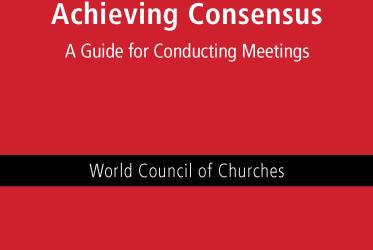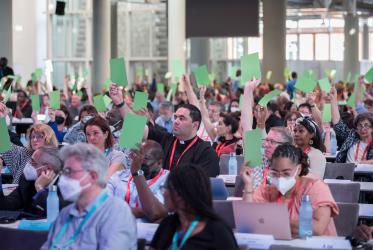"Do not be deceived; God is not mocked, for you reap whatever you sow." (Gal. 6:7)
-
These words of wisdom from Scripture serve as a warning in a new context today. The verse sheds moral light on a modern weapon of war, an indiscriminate instrument that confounds the intentions of its users and brings terrible consequences to its victims. As Christians we live in the light of God's promise that swords will be beaten into ploughshares, spears into pruning hooks, and that people shall not "learn war" any more (Isaiah 2:4). Within this broad mandate to overcome violence, the use of cluster munitions presents a particularly urgent challenge. Designed for the heat of battle, cluster munitions strike and strike when war is over; scattered in combat in an instant, cluster bombs reap a deadly harvest for decades; conceived to stop massed soldiers and tanks, these weapons mostly kill civilians one by one. We hear reports of a nun in Serbia who picked up bomblets scattered in a field and innocently brought them to her convent; of a Lebanese man who put his child in a tree for safety because of bomblets on the ground, only to have a bomblet in the tree kill the boy as the father went for help; of a Laotian mother who died in her garden from one of the millions of bomblets strewn across her country in a war before she was born.
-
Cluster munitions have been used in some 35 countries and regions since World War II including Iraq, Kuwait, Afghanistan, Chechnya, the former Yugoslavia, Angola, Cambodia and Vietnam. In the 2006 war in Israel and Lebanon, some four million cluster bomblets were dropped on southern Lebanon. The United Nations estimates that one million did not explode and that two-thirds of these are scattered in populated areas. Fully 98 percent of the casualties caused by cluster munitions are civilians.
-
A cluster munition is a weapon with multiple explosive submunitions which are dispensed from a container. The submunitions (bomblets) are scattered in order to kill and injure human beings over a wide area. They are designed to detonate in the air or on the ground, but large numbers fail to explode, leaving a deadly post-conflict legacy for local children, women and men.
-
About 75 countries possess cluster munitions. The submunitions in their stockpiles number in the billions, many old and unreliable. Until recently, governments had not taken concerted action to address either the prevalence of cluster munitions or the problems caused by their use. However, the massive and indiscriminate use of cluster munitions at the end of the war in southern Lebanon, after a ceasefire had been agreed, stirred worldwide concern. It served as a tragic catalyst for common action. International awareness of the need to deal with cluster munitions began to grow. More than 80 states and 250 non-governmental organizations have now joined a fast-track process to negotiate a treaty on cluster munitions during 2008. The proposed treaty would prohibit some or all cluster munitions, provide assistance to survivors, help affected communities and require clearance of contaminated land.
-
We believe that cluster munitions must be eliminated because their use causes indiscriminate civilian casualties. These wide-area weapons do not meet the two most important obligations of international humanitarian law to protect civilians during armed conflict: 1) the need to distinguish between civilians and combatants and 2) the need to avoid civilian losses that are out of proportion to direct military gains. Cluster munitions pose severe risks to civilian lives at the time of use and for decades afterward. They also have long-term impacts on peace operations, post-conflict rehabilitation and civilian livelihoods.
-
The calls for certain technical exemptions from a ban are not convincing: Self-destruct mechanisms reduce the number of unexploded bomblets but are still subject to failure themselves, especially under field conditions. Lowering the rate of duds to even one percent still creates unacceptable levels of lethal and dangerous contamination in the targeted area. One percent of a million bomblets is 10,000 bomblets. Neither fix addresses the indiscriminate and disproportionate aspects of initial use. Technical solutions also do not remedy the humanitarian and moral problems inherent in cluster weapons use. What is required is a treaty that applies to all cluster munitions without exception.
Accordingly, and with a view to the so-called "Oslo Process" of negotiating a cluster munition treaty this year, the central committee of the World Council of Churches, meeting in Geneva, Switzerland, 13-20 February 2008:
A. Condemns the use of cluster munitions;
B. Supports the development of a legally binding international treaty to ban the use, production, stockpiling and transfer of cluster munitions, and to require assistance to survivors, help for affected communities and clearance of contaminated land;
C. Commends the governments who have promoted and led the current Oslo Process on cluster munitions, including the governments of Norway, Peru, Austria, New Zealand and Ireland; and urges non-participating governments, including the United States, Russia, China, India, Israel and Pakistan, to join and support this timely multilateral arms control and humanitarian initiative;
D. Commends the cluster munitions control work of the International Committee of the Red Cross and of civil society groups in the Cluster Munition Coalition, noting that the coalition includes various member churches of the WCC and church-related organizations;
E. Encourages member churches of the WCC to become informed about the issue of cluster munitions and the current process to achieve a cluster munition treaty;
F. Recommends that member churches join the international church concern for an effective cluster munition treaty and urge their governments to actively support the treaty process.



